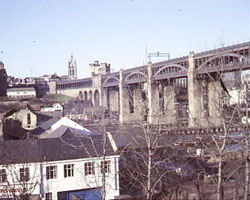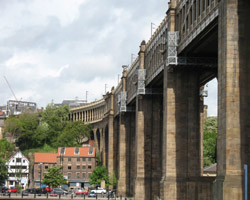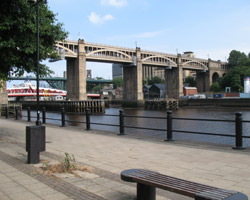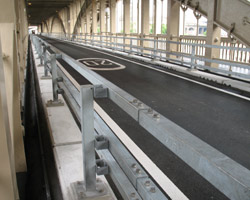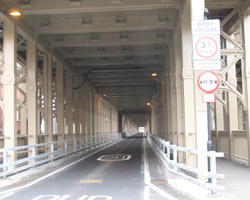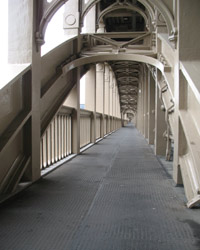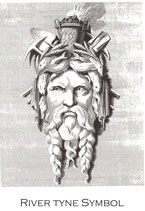
HIGH LEVEL BRIDGE
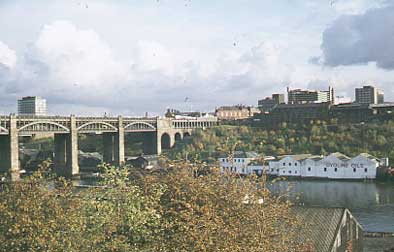
The oldest of the existing bridges, the High Level opened in 1849. Previous bridges had been at a low level, but to avoid steep climbs at either end, a bridge must cross the Tyne gorge much higher. When the need arose for a railway bridge to link the south of England with Newcastle and Edinburgh a high level crossing was a necessity. Previous ideas for road bridges had been proposed and several ideas for rail crossings were put forward but the proposal of the York, Newcastle and Berwick Railway was accepted by Newcastle Council and the design by the celebrated railway engineer Robert Stephenson was to have two decks, the upper for the railway and the lower for the road.
This was the first rail bridge across the Tyne at this point although a bridge already existed west of the city at Scotswood carrying the Newcastle and Carlisle railway. In 1846 building work commenced with the foundations for the piers. The masonry arches followed and then the ironwork, the bridge being completed in June 1849. One-fifth of the ten thousand tons of iron used in its construction came from Bellingham ironworks on the North Tyne. A temporary wooden bridge was first built on the foundations and the permanent bridge was to be erected around it, the temporary bridge meanwhile allowing movement of rail traffic. The temporary timber bridge had one track and was opened in August 1848 although regular traffic over it did not start until September of that year. On completion of the permanent bridge, it was tested with a train on August 11, and on 15 August the first train carrying passengers crossed on its one track then laid. On removal of the temporary bridge the permanent bridge was completed to its full width, sufficient for 3 tracks. Queen Victoria officially opened the High Level on 28 September 1849, apparently without a formal ceremony, her train simply coming to a halt on the new bridge. The road bridge and its approach roads did not come into use until 5 February 1850. Tolls, initially of one penny, were charged until abolition of tolls in 1937, revenue had by then decreased with the opening of the New (free) Tyne Bridge. Horse-drawn vehicles called brakes began running over the bridge from the 1880's at a fare one half-penny. Electric trams linking Newcastle with Gateshead crossed the bridge from 1923, connecting the Newcastle and Gateshead tramway systems. Footways on each side of the bridge were provided for pedestrians. Surprisingly, a few horse-drawn buses continued until 1931.
The bridge is 1338 feet in length, 40 feet wide and the tracks are 112 feet above high water mark. The total cost of bridge and approaches was about £357000. Contractors were Hawks, Crawshay and Co, Messrs Losh, Wilson and Bell, and Abbott and Co, with masonry by Rush and Lawton. The supervising engineer was T. E. Harrison of the North Eastern Railway. A plate at each end of the bridge gives some of these details.
The eastern track was used by 'up' southbound trains and the others were used for 'down, northbound trains with frieight trains using the westernmost track. Recently the railway on the High Level was reduced to two tracks when it was electrified as part of the East Coast Main Line electrification plan in the 1980s. In February 2005 the roadway over the bridge closed completely to enable essential repairs to be undertaken, and there are doubts about whether it will ever reopen to all road vehicles. It is a Grade 1 listed structure and not designed to cope with today's road traffic volumes and its owners, Network Rail, must decide what its future will be.
UPDATE: The bridge re-opened on June 2nd 2008 after a restoration programme costing £43 million. The roadway on the lower deck is now open for southbound (Newcastle to Gateshead) buses and taxis only. This will reduce loads on the bridge. The carriageway has been narrowed to a single lane, there is a speed limit of 20 mph and safety barriers have been fitted. Pedestrians and cyclists can still use the original footpaths at each side of the roadway. The main contractor was May Gurney, project management by Mott MacDonald. Some pictures of the restored bridge are shown below. The first photograph is prior to restoration.
- Constructed - 1846-49
- Type - double deck structure combining principles of arch and suspension, the railway carried on 6 ribbed arches supported by stone piers; the road suspended from the arches by wrought iron rods. 7 stone piers, the railway on cast iron girders.
- Position: between Swing and Metro Bridges
- Grid Ref: NZ 252 637
